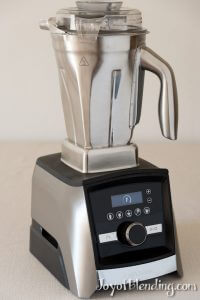 Vitamix just released a new stainless steel container. They previously used metal containers, but stopped making them in the early 1990s. Now metal is back and updated for 2020! Vitamix sent me one to review. If you order via a JoyofBlending link, I get a commission. Thanks!
Vitamix just released a new stainless steel container. They previously used metal containers, but stopped making them in the early 1990s. Now metal is back and updated for 2020! Vitamix sent me one to review. If you order via a JoyofBlending link, I get a commission. Thanks!
Contents
Compatibility
It is compatible with all full-size Vitamix models, which means it has an NFC tag to allow it to work on Ascent and Venturist models. It’s also compatible with machines going back to the early 1990s that look like the 5200. The only modern machines that it is not compatible with are the now-discontinued personal-size S-Series models. It is not compatible with the 4000 and earlier “antique” models.
Introduction
This is a premium option, and their most expensive container, at $199.95. It has a 48-oz capacity, with an extremely similar size and shape to the previous 48-oz container (made out of clear Tritan polymer). I’m impressed with how much of the shape they replicated in stainless steel. There are very slight differences in the handle and the lid.
Handle
The handle is slightly thicker in the middle, which makes it a bit more comfortable to hold. To my eye, it looks like it sticks out from the container more, but it turns out that’s mostly an optical illusion, probably caused by it being solid instead of clear.
Lid
The lid is the exact same shape, but the color is slightly different. Other Vitamix containers and lids have a slight blue tint. The tint is subtle enough that it’s easy to not notice, but I think it was a design choice to make them look more substantial, cleaner, and/or fresher. The less-blue new lid matches the neutral tone of the stainless steel.
The lid seals on the metal container better than the lid on the Ascent 48-oz container. In my vacuum blending investigation, I was surprised that the stock 48-oz container gaskets don’t seal against even the lowest level of vacuum. I tested the metal container, and it sealed all the way to the maximum capability of my vacuum pumps (27 inHg). That means that if you want to try vacuum blending, you can do it without adding the extra o-ring that I previously had to add to the Ascent lids.
Tamper and blades
It uses the same tamper and standard (wet) blades, which means that it delivers Vitamix’s usual great blending performance. The blade on my test unit initially made a slight squeaking noise that I’ve never heard before, but the noise went away after a few uses, and it seems just like the other Vitamix blades now. I’m guessing that it was just a quirk of this particular unit.
Weight
Unsurprisingly, the stainless steel container is heavier. The difference is noticeable, but not enough to make a significant difference, unless you’re spending all day pouring smoothie samples. Weights with lid and lid plug:
Metal 48-oz: 3.28 lb (1.49 kg)
48-oz Ascent: 2.50 lb (1.14 kg)
64-oz Ascent: 2.74oz (1.24 kg)
Heat
The metal is more thermally conductive. In normal use, ingredients are in the container for a short enough time that the increased conductivity won’t make them lose their heat or coldness. The main thing is that the outside of the container heats up with hot blends. If you have a hot soup or drink, in principle you could burn yourself by touching the outside of the container. There’s a hot warning symbol on the outside.
Vitamix warns to use an oven mitt for hot blends. However, the handle itself doesn’t heat up too much. I was able to blend a hot drink (160°F) for multiple minutes and was still able to grab the handle barehanded with no discomfort. They also put a strip of dark grey plastic on the outside of the container under the handle, presumably as a guard to keep your fingers from being burned by the container.
Finish
The stainless steel has a slight brushed finish. The container does show fingerprints more than the Ascent and Pro 750 Stainless Steel bases, which have a protective coating. The container seems to be bare stainless steel. If the fingerprints bother you, you can of course wash or wipe them off.
Volume markings
It has volume markings on the inside. They’re actually easier to read than the ones on clear containers, which have subtle raised clear markings.
Vitamix selling points
Vitamix marketing materials advertise: Durable, Non-Reactive, Easy to Clean, and Odor & Stain Resistant. Those all apply to the standard Tritan containers. I’ve never had problems with odors or stains, though I do know if you blend turmeric in a hot blend, the clear containers can turn yellow. That can easily be bleached out though.
I think the significant difference comes with blending hard items, which scratch the inside of the clear containers and eventually make them cloudy. The stainless steel should stay looking elegant indefinitely. In principle I guess it could get dented, but it feels extremely solid.
Blending
It takes some getting used to to not be able to see the progress of a blend from the side, but it’s not a big deal. As expected, it blends up silky smooth smoothies and soups.
Noise
Some people have asked if the metal makes it quieter. It seems like it’s about the same noise level. If you’re concerned about the noise, I recommend picking up some earmuffs.
Dishwasher safe
I clean Vitamix containers by running them with soapy water, but Vitamix does list this container and lid as dishwasher safe.
Who should buy it?
I haven’t thought of anything that you can make with the new metal container that you can’t make with the standard Vitamix containers. It will make all Vitamix recipes, but that’s not really a reason to buy it. The main reasons are aesthetics and concerns about plastic.
The stainless steel container looks really nice. Some people will just outright prefer it, and others don’t like the looks of their scuffed up old plastic containers.
I personally think that the benefits of eating whole foods (made easier with a Vitamix) far outweigh concerns about food briefly being in a plastic container. But for people who are concerned, now they can get a non-plastic Vitamix container. The lid is still plastic, but honestly, the lid hardly contacts the food. Most of the time the lid gets coated in small splashed droplets that stay on it, so you don’t actually consume them. It also uses the same plastic Vitamix tamper, but again, the tamper is not in contact with the food for very long. If you’re really concerned about the plastic tamper, you can make do without it for all blends except for the absolute thickest ones. In principle you could make your own tamper out of wood.
Finally, if you have a model that came with the low-profile wide 64-oz container, it is nice to add a narrow container for blending small amounts. I’ve been recommending the 32-oz and 48-oz containers as useful extras for years. (This metal container is classified as a “narrow” Vitamix container.) If you’ve been on the fence about getting that extra container, this fancy new one might provide the motivation to get the upgrade.
Check it out: Stainless Steel Container

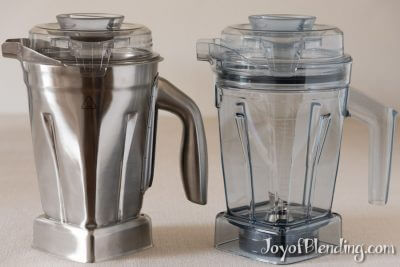
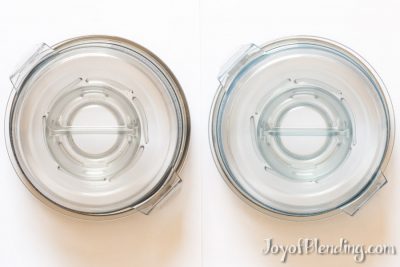
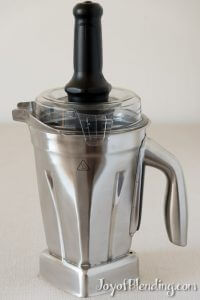
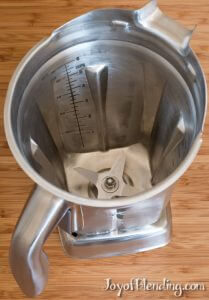
Good to know. I’ve been thinking of getting a new container since current one is so cloudy and scratched after years of frozen smoothies. I’d miss being able to see the progress of the smoothie but that’s a small trade off to have such a clean looking container.
Thanks for the review. I have a metal Waring container that I liked using. I would like a couple of more paragraphs like “Who should buy this” or “Why would you want this”
Thanks I enjoyed the review
Ask and ye shall receive! I added a new section to the end.
I presume you’re referring to the Waring CAC90? I think this new container is nicer than the Waring one in every way, unless you really need that extra 16 oz of capacity. The Vitamix metal container is lower capacity, but its lid seals more securely, so I’m more confident blending at full capacity. The Waring has a line labeled “MAX HOT FILL LINE” at a ridiculously low 16 oz. I always ignored that, but it did make me a bit nervous.
Advantages of this Vitamix container:
Can use tamper
Compatible with Ascent & Venturist models
Volume markings
Nicer ergonomics and styling
Lid (clear and secure)
Warranty (not just 3 years vs 1 year; Vitamix is much more generous with what they cover)
I’m not saying you should ditch your Waring container, but for someone choosing between them, I think the Vitamix container is the clear winner.
I would like to know when it will be available in Australia
This container is perfect for making your own flours in due to it not getting damaged, and I’m turn not holding smells?
Was seeking info if this stainless container makes a considerable difference with ice cream recipes. Obviously hot and cold more sustainable with metal. Yet, how does it work with grinding coffee beans. Making flours. As in, if it works just as well as a dry ( and wet) container, makes better consistency whipped cream, ice cream , doesn’t retain odors ( garlic, onion) and removal of ( butters) proves equal to original plastic, perhaps worthwhile switching up ?
It’s not optimized for dry grinding, but it does work. Check out the video of the wet blade container grinding grain on this page: https://joyofblending.com/is-the-vitamix-dry-container-worth-it/
This stainless steel container is my favorite vitamix accessory, but the absence of a non-plastic lid makes it much less flexible. It is perfect for thick smoothies where there is not much ingredient contact with the lid during blending. It is not always possible to avoid exposing this plastic lid to abrasion or heat though.
Grinding harder ingredients like flaxseed, cinnamon sticks, and star anise in particular would benefit from a non-plastic lid that won’t introduce microplastic debris when it is abraded.
Thinner blends where there is more contact with the lid – especially hot, salty, or acidic ones – would also benefit from a non-plastic lid that isn’t at risk of leeching.
Is it possible to try making a DIY lid to address these concerns similar to your DIY vacuum blending lid experiment?
I don’t see it as a significant issue. Ingredients barely touch the lid, and those hard ingredients you mention mainly slam into the walls of the container around the blades, not the lid.
I’m not sure what material a DIY lid would be made of that would satisfy you. Presumably not acrylic or 3D-printed PLA? I guess wood could be nice, but that would require skill I don’t have and equipment that I don’t have access too. Ceramic could be interesting if one had access to a pottery studio.
Maybe one of these would fit:
https://www.amazon.com/Different-Expandable-Sustainable-Dishwasher-Microwave/dp/B0995XXY5V
I have one of these containers and love it. Use it all the time. I’ve been considering attempting to turn it into a vacuum blending container, but I don’t want to mess with the lid that came with it. I’d much rather find a second lid to “play” with. I haven noticed it’s extremely difficult to find them for this container though. Any leads/ideas on where to find replacement lids for this container?
The only Vitamix replacement parts available from third parties are their commercial ones. Since this lid is different from any of the commercial lids, you won’t find it anywhere other than directly from Vitamix. They don’t list parts on their website, but I’m pretty sure that they’ll sell it if you call.
However, did you see the section of this review where I talked about how the lid on this container seals without modification? The lid for this container is the same as the Ascent lids, so you can follow my Vitamix Ascent DIY vacuum blending instructions, just skip the part about adding an o-ring. The technique I describe there just sits on top of the stock lid, so I don’t see how it would mess it up.
Thank you for the comment. It reminded me to go back to that vacuum blending post and add a note that the stainless steel container lid seals without adding an extra o-ring.
A caveat is that I only have one stainless steel container, and I am not aware of anyone else doing this with a stainless steel container yet. So there is a chance that not all of them seal as well as the one I have, since being able to hold a vacuum is not an official manufacturing spec. If you try it, please report back.
Thanks for replying so quickly. I hadn’t realized that the seal wasn’t actually affixed to the lid. That made the whole thing make a lot more sense. I found some options for people to use that make the vacuum lid much easier to fabricate than the process you used. You can purchase pretty much every part with little to no need of fabrication needed.
The inner edge of the flat portion of the vitamix lid is slightly over 4in in diameter, and the outer edge is just under 4.75in in diameter. Amazon has several 4in silicone flat washers for sale that work perfectly at creating a gasket. I also found that you could buy a 5in diameter 1/4in thick acrylic disk for $13. For the one way air valve this kit of vacuum seal bags comes with everything you need including the pump.
With all these parts I was able to drill a 1/8in diameter hole in the center of the acrylic disk, and a 1/16in diameter hole about an inch to the side of that to use as a vent to release the vacuum. Use a slow drill speed, and a little bit of dish soap as a lubricant while drilling to prevent chipping of the acrylic. Cover the center hole with one of the one way vacuum stickers included in the vacuum seal kit, then a piece of scotch tape with one end folded over as the sealing flap for your vacuum release.
Placing this setup on a glass cook top with the acrylic disk atop the gasket I was able to confirm it created an excellent seal, and the vacuum release worked perfectly as well. Now for the not so great news. They must have changed the design of the stainless steel container from the time you bought yours. At the pour spout, there is now a slight gap where you can see all the way down into the container and no seal is made. I’m going to have to try purchasing some gaskets to see if I can overcome that gap and form a seal.
If you have an email or a way to PM you, I can send you some pictures of the supplies needed and the outcome.
Correction: The lid does seal on my stainless pitcher. The lid comes with the T gasket on the upper indentation on the lid. I moved it to the lower indentation (after looking at some of your pictures and noticing yours was on the lower one), and now the container holds a vacuum.
are you still using this DIY vacuum lid?
I am, and it still works great.
Hello!!
I have an ascent 2300i Vitamix model and I bought this steel container because I wanted a smaller container and also the benefits of the everlasting steel container.
My problem is of course that this container does not fit with international models.
Does this steel jar work with explorian e310 international models? Because the e310 doesnt require the nfc tag to run. So they will run a container regardless of that. So my question is wheather the base of the e310 fits the steel container. Does anyone know wheather this is the case? The amazon webpage says that the steel container doesnt fit any international model.
I personally think that this container might outwear the blender. Its brilliant. Small enough for very small batches by means of the tamper or for spice grinding and durable enough to be used several times a day. You wont need the spice grinder and personal cup. I personally find the 2 litre (64 ounzes) low profile container a seriouos draw back sinces it cannot properly blend anything which is smaller than 2 cups ( half a litre). Since I live in a single house hould this continues to really bother me. I eat a lot of nice cream and I cant process this in small batches in the damn 2 litre container. And the spice grinder and personal cup cant make 3-4 dl of nice cream either. I have to use my immersion blender to do this actually quite demanding job of blending frozen bananas and frozen strawberry. The best results are definitely if I dont add liquid. It gives a much thicker texture. I really hope that I can use my bought steel container on an internationl e310 model. I intend to take it to a store and check it out. (try it out on a e310, that is exhibited). If I had a choice I would actually like to buy an e520, which is my opinion is the best model. No nfc tag and the most useful programs to choose from. Alas Vitamix do not have much on offer, when it comes to international models. Thank you for a great blog!
Yes, the current 48-oz stainless steel container will work on an international E310.
Would of been nice to know about the theory behind the stainless pitcher compared to the wet pitchers a must in my book and the reason to but a vitamix!
Is it possible to get the stainless steel in a 32 OZ pitcher?
I’m not aware of any that are available for sale. Definitely not from Vitamix.
That said, the 48-oz container is the same dimensions as the 32-oz at the very bottom around the blades, so it works just as well for small amounts.